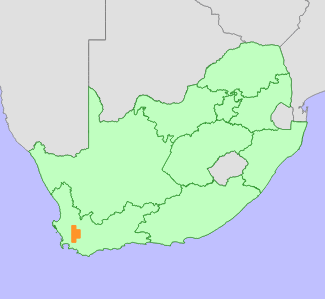|
Scientific Name | Protea nana (P.J.Bergius) Thunb. |
Higher Classification | Dicotyledons |
Family | PROTEACEAE |
Synonyms | Protea rosacea L. |
Common Names | Mountain Rose (e), Mountain-rose Sugarbush (e) |
National Status |
Status and Criteria | Least Concern |
Assessment Date | 2019/06/10 |
Assessor(s) | A.G. Rebelo, H. Mtshali & L. von Staden |
Justification | Protea nana is a range-restricted species, with an extent of occurrence (EOO) of 1241 km², and area of occupancy (AOO) of 260 km². It is known from more than 15 locations and is experiencing some degradation to its habitat from competition with alien invasive plants. Subpopulations are however still very large and this species is not yet in danger of extinction. It is therefore listed as Least Concern. |
Distribution |
Endemism | South African endemic |
Provincial distribution | Western Cape |
Range | This species is endemic to the mountains of the Western Cape Province, South Africa, where it occurs from Du Toit's Kloof to the Groot Winterhoek Mountains and Skurweberg. |
Habitat and Ecology |
Major system | Terrestrial |
Major habitats | South Hex Sandstone Fynbos, North Hex Sandstone Fynbos, Winterhoek Sandstone Fynbos, Hawequas Sandstone Fynbos, Boland Granite Fynbos |
Description | It is found in montane fynbos slopes, 400-900 m. Mature individuals are killed by fires, and only seeds survive. Wind-dispersed seeds are stored in fire-resistant inflorescences, and released after fires. It is pollinated by birds and insects. |
Threats |
| At least 5% of P. nana's habitat is transformed, and loss continues, with 2% loss recorded between 1990 and 2014. Loss was mainly due to vineyards, dam construction at Witzenberg, and pine plantations on slopes of Bain's Kloof. It is currently threatened by competition from infestation by escaping pine seedlings in some parts of the range. As a serotinous reseeder, it is potentially vulnerable to too frequent fires. Local extinctions can occur if fires repeatedly kill individuals before they reach reproductive maturity. |
Population |
This species is typically found in dense, localised stands but can also occur as scattered plants. All remaining subpopulations are confined to nature reserves, and while the population is declining, decline is slow with less than 10% of the population lost to date.
|
Population trend | Stable |
Assessment History |
Taxon assessed |
Status and Criteria |
Citation/Red List version | | Protea nana (P.J.Bergius) Thunb. | Least Concern | Raimondo et al. (2009) | |
Bibliography |
Goldblatt, P. and Manning, J.C. 2000. Cape Plants: A conspectus of the Cape Flora of South Africa. Strelitzia 9. National Botanical Institute, Cape Town.
Manning, J.C. and Goldblatt, P. 2012. Plants of the Greater Cape Floristic Region 1: The Core Cape Flora. Strelitzia 29. South African National Biodiversity Institute, Pretoria.
Raimondo, D., von Staden, L., Foden, W., Victor, J.E., Helme, N.A., Turner, R.C., Kamundi, D.A. and Manyama, P.A. 2009. Red List of South African Plants. Strelitzia 25. South African National Biodiversity Institute, Pretoria.
Rebelo, T. 2001. Sasol Proteas: A field guide to the proteas of southern Africa. (2nd ed.). Fernwood Press, Vlaeberg, Cape Town.
|
Citation |
| Rebelo, A.G., Mtshali, H. & von Staden, L. 2019. Protea nana (P.J.Bergius) Thunb. National Assessment: Red List of South African Plants version 2024.1. Accessed on 2025/12/24 |
 Comment on this assessment
Comment on this assessment

